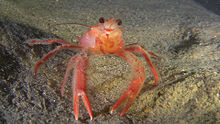| Grimothea planipes | |
|---|---|

| |
| Scientific classification | |
| Domain: | Eukaryota |
| Kingdom: | Animalia |
| Phylum: | Arthropoda |
| Class: | Malacostraca |
| Order: | Decapoda |
| Suborder: | Pleocyemata |
| Infraorder: | Anomura |
| Family: | Munididae |
| Genus: | Grimothea |
| Species: | G. planipes |
| Binomial name | |
| Grimothea planipes (Stimpson, 1860) | |
| Synonyms | |
| |
Grimothea planipes, also known as the pelagic red crab, red crab, or tuna crab, is a species of squat lobster from the eastern Pacific Ocean.
Description
Grimothea planipes is a bright red animal, up to 13 centimetres (5.1 in) long. It resembles a true lobster, but has a shorter abdomen.
Distribution
Grimothea planipes lives on the continental shelf west of Mexico. It is usually found only south-west of San Diego, but in warmer years, its range may extend northwards into California. This is usually indicative of an El Niño event. Adults migrate vertically to near the ocean surface and large numbers occasionally wash up on beaches during warm water events. The southern limit of the species' range is in Chile.
Life cycle
The life cycle of Grimothea planipes appeared for a long time to form a paradox: while an adult population was maintained along the south-western coast of the United States, the planktonic larvae they released were immediately swept by the California Current thousands of miles out to sea. A solution was proposed whereby the larvae use an opposing undercurrent at a lower depth to return to the continental shelf, and this hypothesis was confirmed by sampling different depths of water with a plankton recorder.
Ecology
Grimothea planipes usually feeds on protists and zooplankton, but will feed by filtering blooms of diatoms.
As the most abundant species of micronekton in the California Current, Grimothea planipes fills an important ecological niche converting primary production into energy that larger organisms can use. G. planipes is accordingly an important food item for many species of birds, marine mammals and fish. It is favoured by tuna, leading to one of the species' common names – "tuna crab". Other fish known to feed on G. planipes include billfishes, yellowtail amberjack, sharks and Epinephelus analogus. The diets of gray whales, Bryde's whales, blue whales and sea otters all include G. planipes. The Mexican endemic bat Myotis vivesi also feeds on G. planipes at some times of the year. Off Baja California, the stomachs of some loggerhead sea turtles have been observed to contain only G. planipes. Since G. planipes may be washed ashore in large numbers, it can be a valuable addition to the diets of seabirds such as the herring gull (Larus argentuatus), whose food supply is usually diminished in El Niño years.
References
- ^ Sam Hinton (1987). "Phylum Arthropoda ("joint-limbed animals")". Seashore Life of Southern California: an Introduction to the Animal Life of California Beaches South of Santa Barbara. Issue 26 of California Natural History Guides (2nd ed.). University of California Press. pp. 131–161. ISBN 978-0-520-05924-5.
- Wheeler J. North (1976). "Marine animals: arthropod crustacea, echinoderms, and tunicates". Underwater California. Volume 39 of California Natural History Guides. University of California Press. pp. 207–231. ISBN 978-0-520-03039-8.
- ^ Janet Haig & Donald P. Abbott (1980). "Macrura and Anomura: the ghost shrimps, hermit crabs, and allies". In Robert Hugh Morris; Donald Putnam Abbott & Eugene Clinton Haderlie (eds.). Intertidal Invertebrates of California. Stanford University Press. pp. 577–593. ISBN 978-0-8047-1045-9.
- Ronald H. McPeak; Dale A. Glantz; Carole R. Shaw (1988). "The ever-changing forest". The Amber Forest: Beauty and Biology of California's Submarine Forests. Aqua Quest Publications. pp. 32–41. ISBN 978-0-922769-00-1.
- Kareen Schnabel & Amelia Connell (2007). "Lobster à la carte". Water & Atmosphere. 15 (4).
- Ernest Naylor (2010). "Plankton vertical migration rhythms". Chronobiology of Marine Organisms. Cambridge University Press. pp. 134–149. ISBN 978-0-521-76053-9.
- Alan R. Longhurst, Carl J. Lorenzen & William H. Thomas (1967). "The role of pelagic crabs in the grazing of phytoplankton off Baja California". Ecology. 48 (2): 190–200. doi:10.2307/1933100. JSTOR 1933100.
- Carlos J. Robinson; Vicente Anislado; Antonio Lopez (2004). "The pelagic red crab (Pleuroncodes planipes) related to active upwelling sites in the California Current off the west coast of Baja California". Deep Sea Research Part II: Topical Studies in Oceanography. 51 (6–9): 753–766. doi:10.1016/j.dsr2.2004.05.018.
- Michael H. Horn & Lara A. Ferry-Graham (2006). "Feeding mechanisms and trophic interactions". In Larry Glenn Allen; Daniel J. Pondella & Michael H. Horn (eds.). Ecology of Marine Fishes: California and Adjacent Waters. University of California Press. pp. 387–410. ISBN 978-0-520-24653-9.
- Susan M. Luna & Nicolas Bailly (October 6, 2010). "Epinephelus analogus Gill, 1863, spotted grouper". FishBase. Retrieved February 15, 2011.
- Robert Busch (1998). "The nature of the beast". Gray Whales: Wandering Giants. Heritage House Publishing. pp. 1–66. ISBN 978-1-55143-114-7.
- ^ Mercedes Guerrero, Jorge Urbán y Lorenzo Rojas (2006). "Conocimiento biológico de los cetáceos del Golfo de California". Las Ballenas del Golfo de California (in Spanish). Instituto Nacional de Ecología. pp. 157–406. ISBN 978-968-817-761-7.
- James L. Bodkin (2003). George A. Feldhamer; Bruce Carlyle Thompson; Joseph A. Chapman (eds.). Wild Mammals of North America: Biology, Management, and Conservation (2nd ed.). JHU Press. pp. 735–743. ISBN 978-0-8018-7416-1.
- William Lopez-Forment. "January 6, 2011. Isla Monserrat & Isla del Carmen". Daily Expedition Reports. Lindblad Expeditions & National Geographic. Archived from the original on July 10, 2011. Retrieved February 15, 2011.
- "Caretta caretta (Linnaeus, 1758)". Species Fact Sheets. Food and Agriculture Organization. Retrieved February 15, 2011.
- Brent S. Stewart, Pamela K. Yochem & Ralph W. Schreiber (1984). "Pelagic red crabs as food for gulls: a possible benefit of El Niño" (PDF). The Condor. 86 (3): 341–342. doi:10.2307/1367007. JSTOR 1367007.
| Taxon identifiers | |
|---|---|
| Pleuroncodes planipes | |